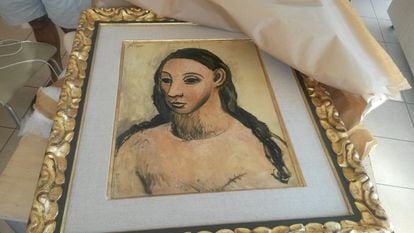The Board of Qualification, Valuation and Export of Goods of the Ministry of Culture met urgently only 24 hours before the alleged
caravaggio
was auctioned
at the Casa Ansorena in Madrid for 1,500 euros, and declared the painting unbearable. In an extraordinary session, this body dedicated, among other functions, to studying the goods that can be sold outside of Spain, protected the work. The botched sale is the most recent episode in a complex story that Spain and Italy have written for centuries. Few countries boast so many artistic treasures. Hence, the respective Ministers of Culture, José Manuel Rodríguez Uribes and Dario Franceschini, agreed this Thursday at a meeting in Rome on the importance of protecting such a vast heritage, on its power of "social and territorial cohesion" and on its value as Economic "lever". The responsibility, at the same time, is also gigantic: the "conservation and enrichment" of these goods is a duty that the two constitutions include.
More information
Two centuries with a 'caravaggio' and 20 days to try to sell it
Culture authorized in 2020 the largest outflow of heritage to sell in history
The Heritage Law, half a century later
The task of identifying, protecting and exposing such a cultural heritage goes beyond the two Administrations.
And any art thief knows it.
Sometimes, whether due to fraud or a simple mistake, a masterpiece sneaks across the border and appears in a private collection or in some prestigious foreign museum.
How is such an immense heritage safeguarded?
“It is very difficult to manage and catalog the heritage of Spain and Italy”, replies Roger Dedeu, an expert lawyer in Cultural Law, from the Gabeiras & Asociados law firm. The Spanish Board, made up of 22 members and a secretary (from the university sphere, from the world of museums, archives, libraries and also from customs, tax and public financial management, as well as representatives from public centers), tries to do so. They meet 11 times a year in full, another 11 to assess export requests and between one and four more times for other procedures. In plenary sessions, lasting up to six hours, they can assess, according to ministry data, a large volume of files: "Between 300 and 600 pages." "It is fully qualified, but logically they cannot know everything about all cultural property",explains Laura Sánchez Gaona, a lawyer specializing in art and cultural heritage who, after years handling cases of this type, demands "more money for Culture to create the necessary means and cross information, as does the Treasury, which is an infallible machine."
The eccehomo removed from the Ansorena auction last April.ANSORENA / MUSEUM OF ART
Between the tide of paperwork and the absence, sometimes, of a clinical eye, checking all the works with a magnifying glass becomes a challenge like the Board. Something that the Italian export offices share in each region but whose management depends on the Ministry of Culture. "The number of files is a problem," acknowledges Professor Domenico D'Orsogna, from the University of Sassari (Sardinia). That is why Italy marked last year at up to 13,500 euros the value below which a piece from the last 70 years does not need an authorization for export. “With so many requests, from time to time something important comes out,” concedes Stefano Alessandrini, ancient art historian and former advisor to the Italian Ministry of Culture. The expert recalls the case of a valuable portrait of Camilo Borghese:"The smart guys" dodged the Rome office and requested the file from another headquarters, where they knew there would be more difficulties in identifying the work. In addition, they presented it as a "manly portrait", omitting the prestigious subject.
Stratagems
Low price, uncertain authorship and attribution.
They are some common stratagems to sneak a jewel into an auction and get it out of Italy or Spain.
The other option is, in Dedeu's words, “a la matador”.
“I remember fruit trucks or moving trucks full of archaeological objects,” explains Alessandrini.
The case of banker Jaime Botín exemplifies this method: when he was denied the export permit for his
picasso, Head of a young woman,
He took it to Corsica on his yacht, with the intention of sending it to Switzerland.
But it also shows the price of breaking the law: the Customs Police stopped the operation, Botín ended up sentenced to three years in prison and the painting is now the property of the Spanish State.
"Another consequence is that if they participate in a dubious or illegal operation, they automatically end up on a distrust blacklist," adds Dedeu.
In the case of Spain, according to the Heritage law, you can incur a crime of smuggling.
'Head of a young woman', by Picasso, owned by Botín.HO / AFP
In 2020, the Spanish Ministry of Culture granted 12,986 pieces the final passport. In the case of wanting to remove works over 100 years old from Spain, the law determines that this procedure is mandatory. The increase in exports, only comparable to the figures for 2016, was due, according to Culture, to the fact that “many antique dealers and auction houses took advantage of the stoppage to request permits for their collections of small pieces, mostly numismatic, appropriate for online sale and easy postal delivery ”. What there is no information on is the procedures or the minutes of the Board, although it is a public body. For Dedeu, here is a piece of the solution: "It cannot be that we discover his criteria in a court ruling." The expert also claimsan “orientation guide” for the owner who requests the export of a work, in the style of the one that exists in England.
The task of identifying, protecting and exposing such a cultural heritage goes beyond the two administrations.
And any art thief knows
In general, both the Spanish board and the Italian offices give the go-ahead to an overwhelming majority of files.
Normally, for being minor works, but not always.
It is not uncommon for works by great prolific and highly represented artists, such as Joaquín Sorolla, to be released.
Both Italian and Spanish law, after all, seek a difficult balance between private property and the public good.
Both allow the possession of pieces that may belong to the national heritage, without the obligation to notify.
But initiating a procedure for its export or sale allows the State not only to have information about the work, but also to become a potential buyer through its right of first refusal.
Official protection, however, is not attractive to many homeowners.
"A series of obligations are imposed on them for their exhibition, analysis or restoration", clarifies Dedeu.
In addition, the owner loses the option to sell the work on the international market, hence its value drops.
In return, you receive tax benefits that almost all experts find unencouraging.
Know the heritage
A complete knowledge is another almost impossible mission. The autonomous communities, from the regional Historical Heritage directorates, are in charge of making their particular valuation, protection and cataloging of the assets. The supposed
caravaggio,
for example, is under the tutelage of the Community of Madrid, since it was in this region that it was found. The Communities' Heritage also carries out inventories, a function that, when carried out independently in each region, multiplies the number of catalogs, their completion deadlines and, therefore, the lack of homogeneity in the classification of Spanish heritage. .
In the case of the Church inventory, the situation is especially complicated. "We have been waiting for it for decades," says Sánchez Gaona. “The law of 85 in article 28 prohibits the alienation of ecclesiastical property to private entities or individuals. That article specifies that they have been inventoried. That is, if it is not inventoried it could be sold ”. But this is just the theory, because as the jurist explains, there is a transitory provision in the law that states that "it would apply to all Church assets until the inventories are finished." Therefore, without these records, no property in the possession of the Church can be sold.
In the past, this lack of control of ecclesiastical property resulted in the plundering of many parishes, churches and monasteries. Not only in the form of theft, but also sales that have not been declared, as well as pieces that end up in auction houses, are acquired and when trying to resell them the problems begin. “It is not fair for an individual to buy a work in good faith without having any idea of its origin, ask for an export permit, authorize it and then when it is discovered that it comes from a convent, they are forced to return it. You cannot ask a merchant for maximum diligence if there are not well-done inventories, ”continues the lawyer. Italy, as Alessandrini recalls, has opted with some success for provincial diocesan museums that bring together at least the most relevant works in ecclesiastical hands. And point another solution:Faced with the looting in remote sites in both countries, he proposes that to acquire a metal detector, a special permit is required, such as for the possession of weapons.
Looting
Italy and Spain have suffered a huge theft of heritage.
Professor D'Orsogna recalls that it was only from 1815 on that the first ideas were spread that pointed out that “works of art belong to everyone”.
Before, basically, the Wild West ruled.
Between the late nineteenth and early twentieth centuries, Spain experienced the era of American treasure hunters, the dealer Arthur Byne and Lionel Harris, owner of The Spanish Art Gallery in London.
During this period, buildings such as the Sacramenia monastery (Segovia) and the Ovila monastery (Guadalajara) emerged, sometimes stone by stone;
dozens of coffered ceilings, tapestries such as the flamenco cloths of the Cathedral of Palencia or Toledo;
remains of fortresses such as Benavente.
Many of these pieces ended up in the lavish compound of newspaper mogul William Randolph Hearst in California.
The Vase of Euphronius.Heritage Images / Getty Images
D'Orsogna cites the famous Euphronius Vase in Italy, stolen from the Cerveteri necropolis and exhibited in the seventies at the Met in New York: on its journey there were lies, millions, dead antiquaries and old
Polaroids
, until it was returned to its country of origin.
Alessandrini mentions the Victorious Athlete of Lysippus, exhibited at the Getty Museum in Malibu and whose final chapter is yet to be written: the Italian Supreme Court ruled in 2018 that the statue should return.
But it hasn't happened yet.
Alessandrini sums it up with a phrase that he snapped years ago to the then director of the New York Metropolitan: "US museums are Ali Babá caves."
Spanish and Italian plundering have led to the development of highly protectionist laws. In Spain, Ricardo de Orueta, from his position as general director of Fine Arts in the Second Republic, set up the Artistic Treasury Law of 1933, one of the most advanced in Europe at that time. In 1985, Javier Solana signed the current Heritage Law, which succeeded that of Orueta. "It was a necessary law in a country as plundered as Spain," says Sánchez Gaona. “It would have to be updated to integrate the facet of cultural goods as a market object. There is some confusion about when one can be restricted in their property rights because the criteria are not clear. That is why many families are afraid of their assets being blocked. The more private interest is taken into account,individuals will find it easier to fulfill their duties and thus take into account their heritage as a collective cultural heritage. Now there is tension, opacity ”, he says.
The Victorious Athlete, also known as the Athlete of Fano, or Lysippus of Fano, is a Greek bronze sculpture made between 300 and 100 BC, which is exhibited among the collections of the J. Paul Getty Museum, in California. Sailko
All the experts consulted agree, yes, that thefts have decreased. In addition to law and controls, diplomacy has contributed above all. Almost all the countries of the world have ratified a Unesco convention with which they undertake not to acquire or import cultural property of doubtful origin. Although the free zone of the Geneva airport continues to guard a millionaire artistic treasure, several experts recall. Italy has also signed collaboration agreements not only with other countries, but even with museums such as the Met itself. "The custom is being created whereby States must seek in good faith a balanced solution," adds D'Orsogna. And that does not always lead to the return of a work: sometimes, the country of origin can settle for having its membership recognized and granting a long-term loan.At the times of robberies, those of good sense are happening. Better for everyone. And for the heritage.
Hunting for 'sleepers'
Stefano Alessandrini is known in the industry as a "hunter of works".
And he likes it.
Kind of like the
Monument Men
, albeit with less adventure and more paperwork.
Because the Italian expert spends many nights researching gallery catalogs, auctions, museums.
He contrasts them with the police files of works stolen, disappeared or even looted by the Nazis.
And every now and then, he comes across a prize, like an Etruscan statuette of Hercules that appeared in an antiquarian in New York.
Others do not hunt for illicit game, but they do hunt for hidden treasures. The appearance of the supposed
caravaggio
has once again awakened the interest of the art market in Spain, a country in which, for collectors like Nicolás Cortés, “hidden gems” can still be found, but not in the same quantity as in Italy. The antiquarian has on its payroll four experts - "It would be necessary to have an army" - who every week review the catalogs of the auctions around the world in search of these 'sleepers', the wrongly cataloged works, the ugly, the dirty, the that try to go unnoticed in a corner. They seek to win the Euromillion. And it rarely happens: "This level in Spain happens once every 50 years."





/cloudfront-eu-central-1.images.arcpublishing.com/prisa/GPRAVPQ5NFMQ5HQDCG3AMDZELQ.jpg)


